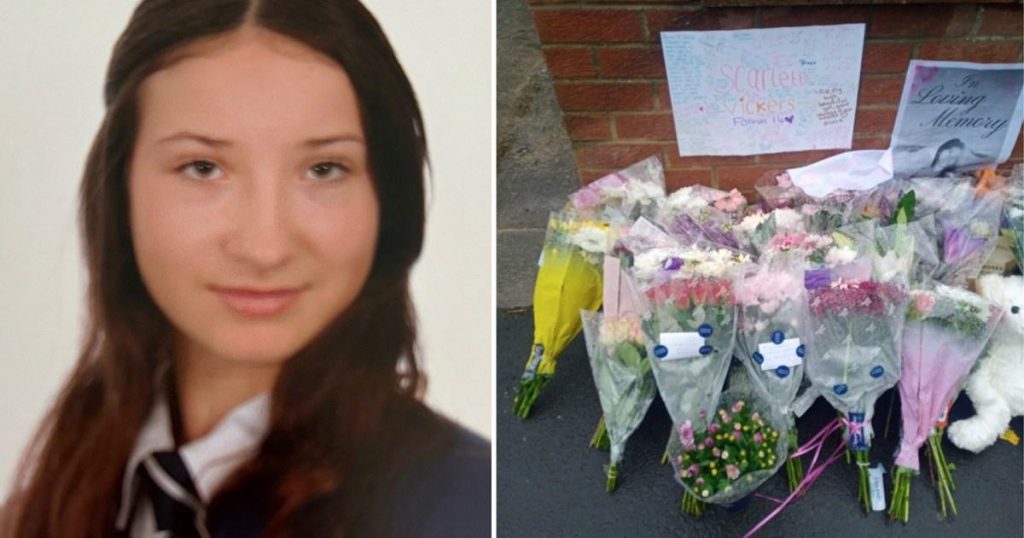Fourteen-year-old Scarlett Vickers tragically lost her life in July at her Darlington home due to a single stab wound to the chest. Her father, Simon Vickers, 50, stands accused of murder and manslaughter, but maintains his innocence, claiming the fatal injury was a tragic accident during playful interaction with his daughter. The prosecution, however, contends that the nature and severity of the wound point to a deliberate act. The trial centers on conflicting narratives of a family evening that turned deadly.
Vickers’ account depicts a scene of innocent horseplay in the kitchen while his partner, Sarah Hall, prepared tea. He describes throwing grapes and tongs at Scarlett, followed by her throwing objects back at him. He claims that during this exchange, he unknowingly picked up a kitchen knife and that Scarlett then “lunged” towards him, resulting in the blade accidentally penetrating her chest. He asserts the action was unintentional and lacked force, stating, “It wasn’t even hard, it was nothing.” He claims neither he nor Hall immediately realized Scarlett was injured until she cried out.
The prosecution paints a different picture, arguing that the four-inch deep wound, which pierced Scarlett’s lung and heart, could not have been inflicted accidentally. They emphasize the depth and trajectory of the wound, suggesting a deliberate stabbing motion rather than an accidental impact. They challenge Vickers’ version of events, pointing out the improbability of such a severe injury resulting from the scenario he describes. The prosecution highlights the fact that Vickers and Hall were the only other individuals present at the time, making their accounts crucial to understanding what transpired.
The prosecution’s case rests on the expert testimony of Home Office pathologist Dr. Jennifer Bolton, whose post-mortem examination concluded that the nature of the wound was consistent with a deliberate stabbing motion. This contradicts Vickers’ claim of an accidental impalement during playful interaction. Dr. Bolton’s findings regarding the depth of the wound and the path it took through Scarlett’s chest cavity form a cornerstone of the prosecution’s argument, directly challenging the defense’s narrative of an unintentional tragedy.
The defense, led by Nicholas Lumley KC, maintains that Vickers and Hall deeply loved their daughter and had no intention of harming her. They portray Vickers as a loving father who is now burdened by the unintentional death of his only child. The defense emphasizes Vickers’ immediate remorse and distress following the incident, highlighting his reported statements to police expressing his confusion and devastation. The defense’s strategy seeks to portray the incident as a tragic accident for which Vickers bears moral responsibility, but not criminal culpability. They underscore that Vickers had no motive to harm Scarlett and that the events were a tragic consequence of playful interaction that went horribly wrong.
The trial thus hinges on the jury’s interpretation of the evidence presented. Will they accept Vickers’ account of a tragic accident amidst playful interaction, or will they be persuaded by the prosecution’s argument that the nature of the wound indicates a deliberate act? The conflicting narratives, supported by expert testimony and witness accounts, present a complex challenge for the jury as they determine Vickers’ fate. The case underscores the devastating consequences that can arise from seemingly innocuous actions, leaving a family shattered and a father facing serious charges.
The outcome of the trial rests on the jury’s assessment of the evidence. They must weigh the conflicting narratives and the expert testimony to determine whether Scarlett’s death was a tragic accident, as claimed by the defense, or a deliberate act of violence, as argued by the prosecution. The trial is scheduled to continue, with further evidence and witness testimonies expected to shed more light on the events that led to Scarlett’s untimely death. The case highlights the devastating consequences that can arise from everyday interactions and the challenging task faced by the justice system in unraveling the truth behind such tragic events.




